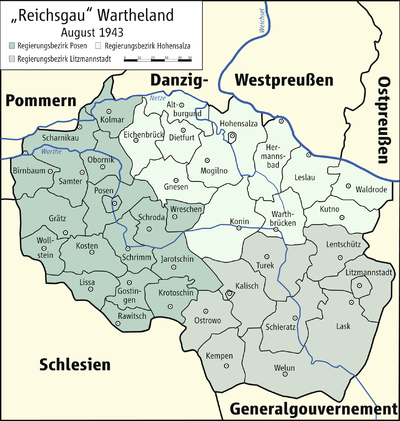Gnesen district

Gnesen district was the name of a German administrative unit in occupied Poland (1939–1945) during the Second World War .
Prehistory (1815 to 1920)
The area around the western Polish city of Gniezno belonged to the Prussian province of Posen as the district of Gnesen from 1815 to 1919 . In the course of the Wielkopolska Uprising , Gniezno came under Polish control on December 27, 1918 and was officially ceded to newly founded Poland on June 28, 1919 with the signing of the Versailles Treaty .
Administrative history
At the beginning of the Second World War , German troops occupied the western Polish powiat Gniezno , the district town of Gniezno was taken on September 11, 1939.
On October 26, 1939, the powiat was annexed to the German Reich under the name Gnesen district , which, as a unilateral act of violence, was ineffective under international law. The district became part of the administrative district Hohensalza in the Reichsgau Wartheland .
The seat of the German district office became the district town Gnesen, which did not belong to the district, but formed its own urban district .
The German occupation ended with the invasion of the Red Army in January 1945.
politics
Land Commissioner
- 1939 : Günther von Schroeter
District administrators
- 1939–1940: Günther von Schroeter ( provisional )
- 1940–1945: Büttner
Municipal structure
The localities of the district were initially grouped into twelve administrative districts . On April 1, 1942, some districts were merged. Towards the end of the occupation, the district consisted of nine administrative districts.
size
The district of Gnesen (including the urban district) had an area of 1107 km².
population
In 1941, the Gnesen district had 56,776 inhabitants, most of them Polish. The German occupation authorities expelled over 10,000 Poles from the area between December 1, 1939 and December 31, 1943. A small German minority lived in the area, and Germans were also settled during the occupation. Towards the end of the occupation, most of them left the area.
The Jewish population was deported to the General Government and murdered there.
Place names
The local occupation authorities gave all localities in the district German names, some new German names, although according to an unpublished decree of the Interior Minister of December 29, 1939, the German names valid from 1918 should initially continue to apply. On May 18, 1943, German names were again set for all places with a post or train station in the Wartheland , although there were again deviations.
List of cities and administrative districts in the Gnesen district:
| Polish name | German name (1918) | German name (1939-1945) |
|---|---|---|
| Czerniejewo | Schwarzenau | Schwarzenau |
| Gniezno | Gniezno | Gniezno |
| Kiszkowo | Welnau | Welnau |
| Kłecko | Kletzko | Blocks |
| Łubowo | Libau | Libau |
| Mieleszyn | Hohenau |
1939–1943 Hohenau 1943–1945 Wulfgrammsau |
| Niechanowo | Niechanowo | Niedorf |
| Powidz | Powidz | Kurheim |
| Witkowo | Witkowo | Wittingen |
Web links
- Gnesen district administrative history and the district administrators on the website territorial.de (Rolf Jehke), as of August 20, 2013.